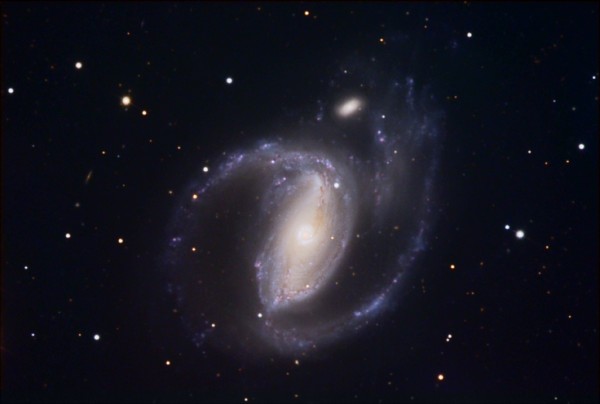Battle not with monsters, lest ye become a monster. And if you gaze long into the abyss, the abyss also gazes into you. --F. Nietzsche
That's supposed to be a metaphor, right? Not so, says NGC 1097. In visible light, it just looks like a barred spiral galaxy:

But damn if the abyss isn't gazing back at us in the infrared. From the Spitzer Space Telescope:

Universe Today has the full story on what we're seeing. You're going to have to go there; apparently, I have a monster to battle.
More like this
You are a giant swarm of Antarctic krill migrating daily from sunli
"Pet" Giant Pycnogonid attacking computer.
For centuries we've languished in the abyss of not-knowing what science is. An abyss so deep and so languishable, that we didn't even know we didn't know. A true Rumsfeldian dilemma, with mixed metaphors to boot. What accounts for scientific excellence and credibility?

Thanks for this great shot, and I like your literary flair. The "eye" does look more dramatic in IR, but you can see it well enough in the visible shot. One thing I wonder about older use of IR astronomy: when they were still wondering about the "green" areas of Mars being vegetation, didn't someone think to do the near IR (at least spectroscopic if not image) to see if that resembled plant reflection? And there are so few nice astronomical IR Ektachrome shots, that I can find at least.
Neil,
The problem is that IR is hard to do from the ground; the atmosphere really gets in the way. By time we had telescopes like UKIRT up and running, we knew better about Mars. In fact, it wasn't even until the launch of the satellite COBE that we got to see the Milky Way in infrared; check it out!
That's why Spitzer, Herschel, and the big Hubble successor, James Webb, are all poised to take advantage of doing IR in space!
Thanks for this great shot, and I like your literary flair. The "eye" does look more dramatic in IR, but you can see it well enough in the visible shot. One thing I wonder about older use of IR astronomy: when they were still wondering about the "green" areas of Mars being vegetation, didn't someone think to do the near IR (at least spectroscopic if not image) to see if that resembled plant reflection? And there are so few nice astronomical IR Ektachrome shots, that I can find at least.
Thanks for this great shot, and I like your literary flair. The "eye" does look more dramatic in IR, but you can see it well enough in the visible shot. One thing I wonder about older use of IR astronomy: when they were still wondering about the "green" areas of Mars being vegetation, didn't someone think to do the near IR (at least spectroscopic if not image) to see if that resembled plant reflection? And there are so few nice astronomical IR Ektachrome shots, that I can find at least.
Thanks for this great shot, and I like your literary flair. The "eye" does look more dramatic in IR, but you can see it well enough in the visible shot. One thing I wonder about older use of IR astronomy: when they were still wondering about the "green" areas of Mars being vegetation, didn't someone think to do the near IR (at least spectroscopic if not image) to see if that resembled plant reflection? And there are so few nice astronomical IR Ektachrome shots, that I can find at least.
Thanks for this great shot, and I like your literary flair. The "eye" does look more dramatic in IR, but you can see it well enough in the visible shot. One thing I wonder about older use of IR astronomy: when they were still wondering about the "green" areas of Mars being vegetation, didn't someone think to do the near IR (at least spectroscopic if not image) to see if that resembled plant reflection? And there are so few nice astronomical IR Ektachrome shots, that I can find at least.
Thanks for this great shot, and I like your literary flair. The "eye" does look more dramatic in IR, but you can see it well enough in the visible shot. One thing I wonder about older use of IR astronomy: when they were still wondering about the "green" areas of Mars being vegetation, didn't someone think to do the near IR (at least spectroscopic if not image) to see if that resembled plant reflection? And there are so few nice astronomical IR Ektachrome shots, that I can find at least.
Thanks for this great shot, and I like your literary flair. The "eye" does look more dramatic in IR, but you can see it well enough in the visible shot. One thing I wonder about older use of IR astronomy: when they were still wondering about the "green" areas of Mars being vegetation, didn't someone think to do the near IR (at least spectroscopic if not image) to see if that resembled plant reflection? And there are so few nice astronomical IR Ektachrome shots, that I can find at least.
Thanks for this great shot, and I like your literary flair. The "eye" does look more dramatic in IR, but you can see it well enough in the visible shot. One thing I wonder about older use of IR astronomy: when they were still wondering about the "green" areas of Mars being vegetation, didn't someone think to do the near IR (at least spectroscopic if not image) to see if that resembled plant reflection? And there are so few nice astronomical IR Ektachrome shots, that I can find at least.